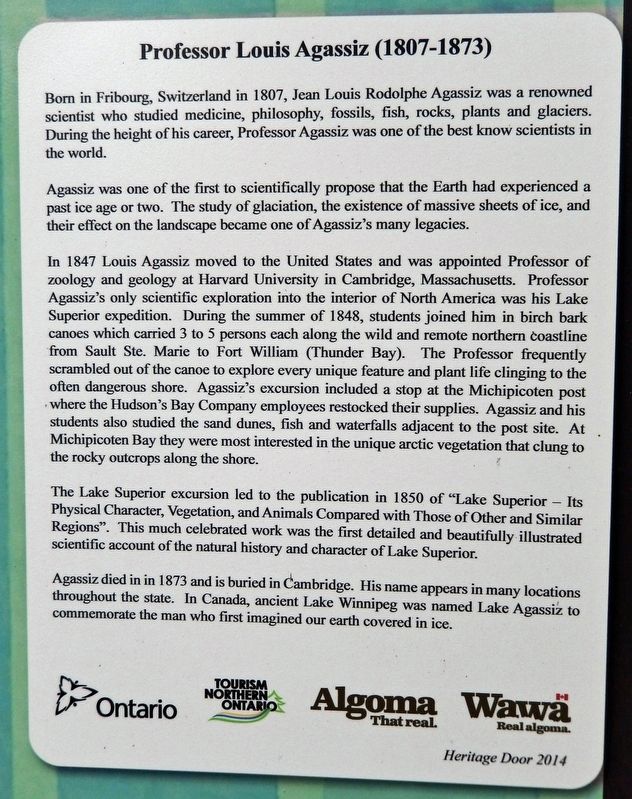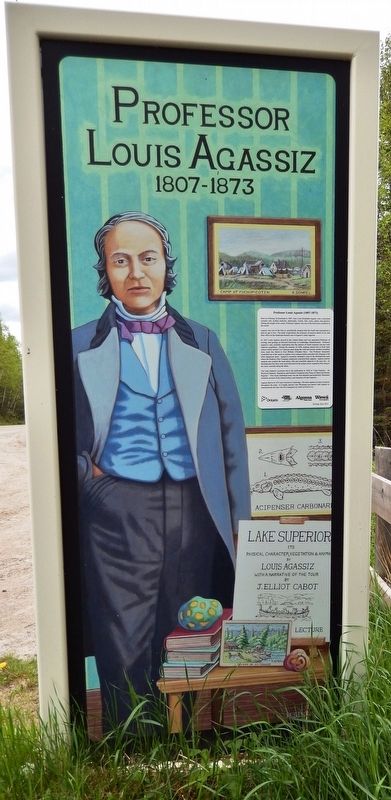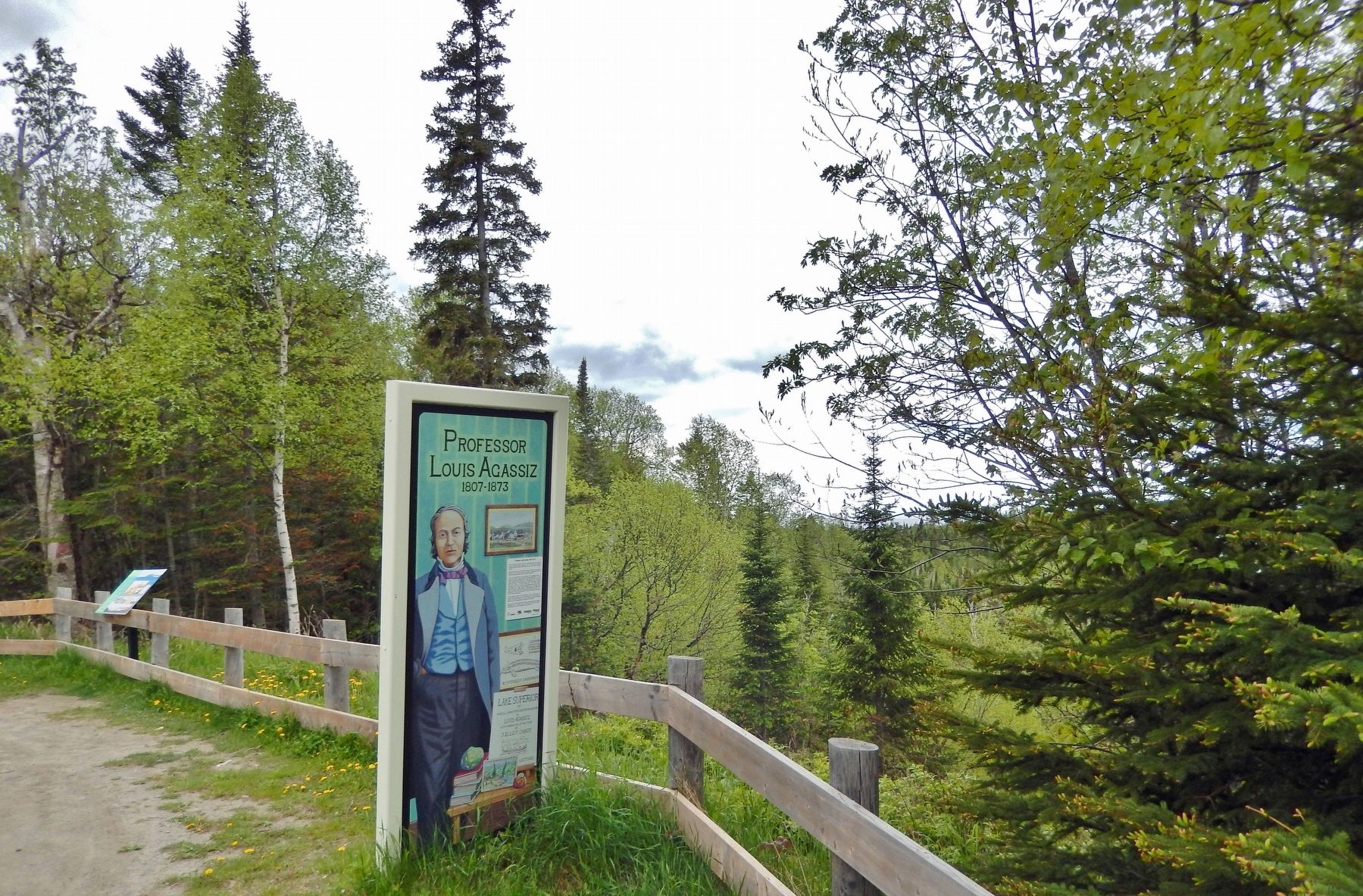Michipicoten in Wawa in Algoma District, Ontario — Central Canada (North America)
Professor Lewis Agassiz (1807-1873)
Born in Fribourg, Switzerland in 1807, Jean Louis Rodolphe Agassiz was a renowned scientist who studied medicine, philosophy, fossils, fish, rocks, plants and glaciers. During the height of his career, Professor Agassiz was one of the best known scientists in the world.
Agassiz was one of the first to scientifically propose that the Earth had experienced a past ice age or two. The study of glaciation, the existence of massive sheets of ice, and their effect on the landscape became one of Agassiz's many legacies.
In 1847 Louis Agassiz moved to the United States and was appointed Professor of zoology and geology at Harvard University in Cambridge, Massachusetts. Professor Agassiz's only scientific exploration into the interior of North America was his Lake Superior expedition. During the summer of 1848, students joined him in birch bark canoes which carried 3 to 5 persons each along the wild and remote northern coastline from Sault Ste. Marie to Fort William (Thunder Bay). The Professor frequently scrambled out of the canoe to explore every unique feature and plant life clinging to the often dangerous shore. Agassiz's excursion included a stop at the Michipicoten post where the Hudson's Bay Company employees restocked their supplies. Agassiz and his students also studied the sand dunes, fish and waterfalls adjacent to the post site. At Michipicoten Bay they were most interested in the unique arctic vegetation that clung to the rocky outcrops along the shore.
The Lake Superior excursion led to the publication in 1850 of "Lake Superior — Its Physical Character, Vegetation, and Animals Compared with Those of Other and Similar Regions". This much celebrated work was the first detailed and beautifully illustrated scientific account of the natural history and character of Lake Superior.
Agassiz died in 1873 and is buried in Cambridge. His name appears in many locations throughout the state. In Canada, ancient Lake Winnipeg was named Lake Agassiz to commemorate the man who first imagined our earth covered in ice.
Erected 2014 by Wawa Heritage Doors.
Topics. This historical marker is listed in these topic lists: Education • Exploration • Science & Medicine • Waterways & Vessels. A significant historical year for this entry is 1848.
Location. 47° 56.517′ N, 84° 50.251′ W. Marker is in Wawa, Ontario, in Algoma District. It is in Michipicoten. Marker is on Michipicoten Harbour Road, 1.5 kilometers west of Queen Street, on the left when traveling west. Marker is located at the Lake Superior Scenic Lookout. Touch for map. Marker is in this post office area: Wawa ON P0S 1K0, Canada. Touch for directions.
Other nearby markers. At least 8 other markers are within walking distance of this marker. Alexander Young Jackson (1882-1974) (here, next to this marker); Michipicoten Scenic Lookout (a few steps from this marker); Michipicoten River Cemetery (approx. half a kilometer away); Louisa MacKenzie Bethune (1793-1833) (approx. 0.6 kilometers away); The Fur Trade at Michipicoten (approx. 0.6 kilometers away); Captain Arthur Batten & S.S. Caribou (approx. one kilometer away); Government Dock (approx. one kilometer away); Morley Callaghan (1903-1990) (approx. one kilometer away). Touch for a list and map of all markers in Wawa.
Also see . . .
1. Louis Agassiz.
Agassiz is known for observational data gathering and analysis. He made institutional and scientific contributions to zoology, geology, and related areas, including multivolume research books running to thousands of pages. He is particularly known for his contributions to ichthyological classification, including of extinct species such as megalodon, and to the study of historical geology, including the founding of glaciology. In 1837, Agassiz proposed that the Earth had been subjected to a past ice age. He presented the theory to the Helvetic Society that ancient glaciers flowed outward from the Alps, and even larger glaciers had covered the plains and mountains of Europe, Asia, and North America and smothered the entire Northern Hemisphere in a prolonged ice age.(Submitted on March 18, 2023, by Cosmos Mariner of Cape Canaveral, Florida.)
2. Louis Agassiz.
In 1846 Agassiz visited the United States for the general purpose of studying natural history and geology there but more specifically to give a course of lectures at the Lowell Institute in Boston. The lectures were followed by another series in Charleston and, later, by both popular and technical lectures in various cities. In 1847 he accepted a professorship of zoology at Harvard University.(Submitted on March 18, 2023, by Cosmos Mariner of Cape Canaveral, Florida.)
3. Wawa Heritage Doors - portals into our past!.
"Wawa's Heritage Doors are a truly creative and effective way to combine history and art in a visually attractive cultural display for both Wawa residents and visitors to enjoy!"(Submitted on March 18, 2023, by Cosmos Mariner of Cape Canaveral, Florida.)
4. The man who discovered the ice age.
More than 170 years ago, Switzerland’s father of glaciology Louis Agassiz took some of the field’s first glacial movement measurements – becoming the first scientist to formally propose the idea that a past ice age once covered the majority of Europe. Born in 1807 in the Swiss village of Môtier, Agassiz presented his findings on glacial movement at a time when few scientists had ever considered that many parts of Europe had once been buried under ice.(Submitted on March 27, 2023, by Cosmos Mariner of Cape Canaveral, Florida.)
Credits. This page was last revised on March 27, 2023. It was originally submitted on March 16, 2023, by Cosmos Mariner of Cape Canaveral, Florida. This page has been viewed 83 times since then and 5 times this year. Photos: 1, 2, 3. submitted on March 18, 2023, by Cosmos Mariner of Cape Canaveral, Florida.


